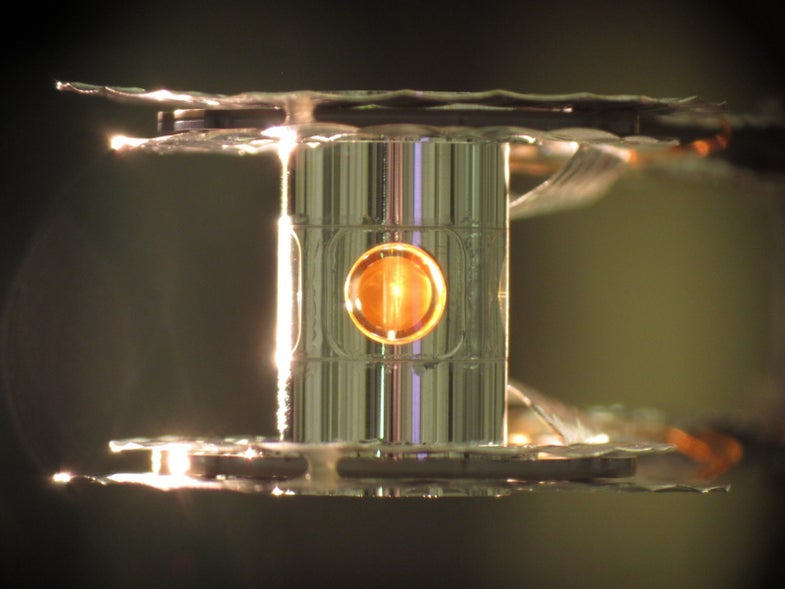How To Prove That Light Can Be Converted Into Matter
A decades-old hypothesis gets closer to solidity.


Hohlraum
In 1934, two American physicists theorized that if one could make two photons collide, the collision would produce two positron-electron pairs—and thus convert light into matter. If proven in a lab, the process would be a pure demonstration of Einstein’s theory of relativity, E=mc2, which states that the mass of an object is also a measure of its stored energy. At the time the scientists—Gregory Breit and John A. Wheeler, physicists at New York University—devised their hypothesis, there were no scientific tools available to demonstrate it, so the pair was left only with a theory, a very sound theory known thereafter as the Breit-Wheeler process, until technology could catch up.
Exactly 80 years later, that time has finally arrived: theoretical physicists at Imperial College London have stumbled, quite by accident, upon a method that will demonstrate Breit and Wheeler’s theory. In a study published this month in Nature Photonics, the team describes how, while researching problems related to fusion energy, they realized that by firing high-energy lasers into a hohlraum—a tiny, gold can that absorbs laser radiation and symmetrically re-radiates it as x-rays—scientists could create a “photon-photon collider,” successfully spinning matter particles off of high-energy photons.
The theory could be demonstrated within a year.
Since the people who devised the experiment deal only in theoretical physics, and since the actual procedure will require a large team of experimenters, Pike’s team is currently in the process of gathering other researchers to properly see the experiment through. He says it could be completed “within a year,” depending on how quickly the team can secure one of only about 10 laboratory facilities in the world that contain the equipment needed to perform the experiment: both short-pulse laser capabilities and either a hohlraum or some other mechanism to generate a large number of x-rays. The process involves a formal, peer-reviewed proposal that must be greenlit by a committee from the facility based on its thorough presentation, personnel expertise, and ultimate importance to science. They likely won’t have a problem with that last one—when successfully conducted, this experiment will have realized, in its purest form, a process crucial to the understanding of both gamma ray bursts and the first few minutes of the formation of the universe.
“The Breit-Wheeler process [has been] so elusive because the number of light particles required to see it is very high,” lead researcher Oliver Pike tells Popular Science. “Trying to collide two photons using two high-energy light beams has, to date, not worked, [because] it is very difficult to generate dense and narrow beams of the energies required to detect the process. Our approach was different. Laser-heated hohlraums have been used for decades, and high-intensity lasers have been able to accelerate electrons to the very high energies required to generate the light beam for about 10 years. I just don’t think that anyone had thought of using a hohlraum as a tool to study fundamental physics before.”
This isn’t the first time light has been converted into matter: in 1997, Stanford’s linear collider used a different process that involved large numbers of photons interacting with the help of a high-powered electron beam and an electric field that provided the energy needed to collide the photons to produce matter particles. The Imperial College London team’s experiment, by contrast, uses the energy of the two colliding photons themselves—it’ll be the first time light has been converted into matter in a total vacuum, thus making the process much easier to observe.
“The idea of creating a photon-photon collider is one that has long interested physicists,” says Pike. “Many different particles can be produced in photon collisions, so such a collider could potentially be used to study fundamental physics with a very clean experimental approach. [It] could be used as an antimatter source—useful in PET scanning, for example—as equal numbers of electrons and positrons are formed, but there are much easier and more efficient ways of creating antimatter than this. Applications [of the process] may arise in the future, but at the moment, the main draw of this experiment is certainly academic: observing a very simple process for the first time.”
While modern technology finally makes it possible to conduct the Breit-Wheeler process for the first time, Pike says they’ll have only just begun to scratch the surface of its capabilities; as lasers become more powerful over time, scientists will be able to produce more and different particles than just positron-electron pairs. He says their initial discovery, though accidental, was ultimately an inevitable scientific advance.
“This process is a little odd in that, theoretically, its validity is not really in any doubt,” he says. “It’s just that in the past we haven’t had any way of detecting it, whereas closely related processes—like the annihilation of an electron and positron into two photons—were seen decades ago. If we hadn’t published this work, I’m sure someone at some point in the future would have made efforts to observe it.”